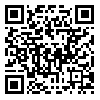Background & Aims: Studies show that body mass index (BMI) can predict success rate of extracorporeal shock wave lithotripsy (ESWL). In this study, we aimed to evaluate the relation between BMI and waist circumference with success rate of ESWL and stone free rate after ESWL.
Materials & Methods : In a descriptive cross-sectional study, 64 patients with kidney stone size 0.5 to 2 cm for urinary tract lithotripsy were studied. In all patients waist circumference, weight and height were measured at first refer. Stone analysis was done after lithotripsy. Also, in order to determine residual stones in week 6 after ESWL, kidney radiographs were taken.
Results : In 64 patients including 43(67.2%) men and 21(32.8%)women, the average stone size was 12.90±3.99 mm. The patients' mean BMI was 25.91±4.34 kg/m2 and waist circumference was 89.82±14.43 cm. Thirty tree patients (51.6%) were stone free and 31 (48.4%) had residual stone. There was no significant difference between stone free rate and sex, stone location and mean BMI. There was no significant difference in waist circumference between groups.
Conclusion : Results of this study showed that body mass index and waist circumference have no role in predicting response to ESWL treatment and stone free rate after ESWL.
Source: Urmia Med J 2011: 22(5): 489 ISSN: 1027-3727
| Rights and permissions | |
 |
This work is licensed under a Creative Commons Attribution-NonCommercial 4.0 International License. |


